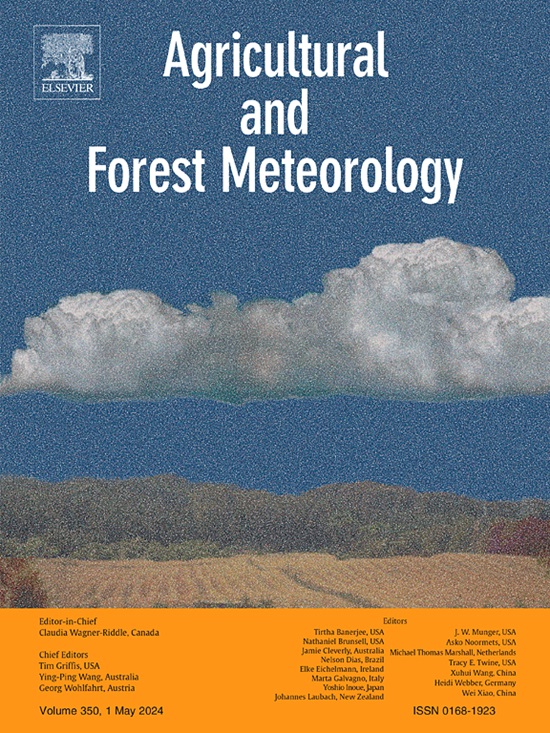Interannual climatic sensitivity of surface energy flux densities and evapotranspiration in a disturbed and rewetted ombrotrophic bog
IF 5.6
1区 农林科学
Q1 AGRONOMY
引用次数: 0
Abstract
This study quantified surface energy balance and evapotranspiration in a Sphagnum-dominated ombrotrophic bog located near their southern limit in western North America (49.13 N, 122.98 W) from summer 2014 through 2022 to assess the bog's sensitivity to future climatic conditions, particularly to increasing severity and duration of drought conditions. Precipitation exceeded evapotranspiration in winter, but net surface water exchange was negative for between four and six months in summer. Shifts in surface water exchange towards net gain occurred consistently between early September and late October; the timing of the shift towards net loss was less consistent in spring, ranging from mid-February to mid-May. Daily evapotranspiration was primarily driven by net radiation and vapour pressure deficit. Surface moisture availability, as represented by water table depth, was a secondary control. Evapotranspiration tended to decline with increasing water table depth, with a slight flattening of the relation below a depth of about 0.058 m. The initial, more rapid, rate of decline is hypothesized to reflect a decrease of surface ponding and the decreased effect at greater depths to be associated with continued supply of water to the peat surface by capillary transport. Albedo increased from about 0.10 to 0.14 over each growing season, but the negative feedback on available energy for evapotranspiration at the peat surface was minimal. Net radiation did not vary substantially among years, and maximum seasonal water table drawdown appeared to be most strongly associated with growing season vapour pressure deficit, and was not correlated with the duration of seasonal net water loss to the atmosphere. In a climate change context, this study suggests that the ecohydrological response of ombrotrophic bogs will be most sensitive to changes in summertime vapour pressure deficit, which is projected to increase in the future.
扰动和复湿的营养化沼泽地表能量通量密度和蒸散的年际气候敏感性
本研究从2014年夏季到2022年,量化了位于北美西部南部边界附近(49.13°N, 122.98°W)的一个以泥炭属植物为主的疏养沼泽的地表能量平衡和蒸散量,以评估该沼泽对未来气候条件的敏感性,尤其是对日益严重和持续的干旱条件的敏感性。冬季降水超过蒸散,但夏季4 ~ 6个月的净地表水交换为负。地表水交换向净收益的转变在9月初至10月底之间持续发生;转向净损失的时间在春季不太一致,从2月中旬到5月中旬不等。日蒸散主要由净辐射和蒸汽压亏缺驱动。以地下水位深度表示的地表水分有效性是次要控制因素。随着地下水位的增加,蒸散量呈下降趋势,在约0.058 m深度以下关系略有平缓。据推测,最初的、更迅速的下降速度反映了地表池塘的减少,而在更深的地方,与通过毛细输送持续向泥炭地表供水有关的影响减弱。每个生长季节的反照率从0.10左右增加到0.14,但泥炭地表蒸腾有效能的负反馈最小。净辐射在年际间变化不大,最大季节性地下水位下降似乎与季节蒸汽压亏缺最密切相关,而与季节大气净水分损失的持续时间无关。在气候变化背景下,本研究表明,同养沼泽的生态水文响应将对夏季蒸汽压亏缺的变化最为敏感,预计未来蒸汽压亏缺将增加。
本文章由计算机程序翻译,如有差异,请以英文原文为准。
求助全文
约1分钟内获得全文
求助全文
来源期刊
CiteScore
10.30
自引率
9.70%
发文量
415
审稿时长
69 days
期刊介绍:
Agricultural and Forest Meteorology is an international journal for the publication of original articles and reviews on the inter-relationship between meteorology, agriculture, forestry, and natural ecosystems. Emphasis is on basic and applied scientific research relevant to practical problems in the field of plant and soil sciences, ecology and biogeochemistry as affected by weather as well as climate variability and change. Theoretical models should be tested against experimental data. Articles must appeal to an international audience. Special issues devoted to single topics are also published.
Typical topics include canopy micrometeorology (e.g. canopy radiation transfer, turbulence near the ground, evapotranspiration, energy balance, fluxes of trace gases), micrometeorological instrumentation (e.g., sensors for trace gases, flux measurement instruments, radiation measurement techniques), aerobiology (e.g. the dispersion of pollen, spores, insects and pesticides), biometeorology (e.g. the effect of weather and climate on plant distribution, crop yield, water-use efficiency, and plant phenology), forest-fire/weather interactions, and feedbacks from vegetation to weather and the climate system.

 求助内容:
求助内容: 应助结果提醒方式:
应助结果提醒方式:


